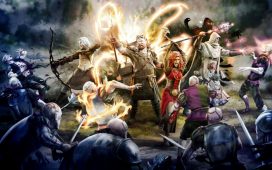Many games sell themselves with their gameplay, especially if they’re not part of established franchises. For video games, more like any other media, including board games, neat categorisation is intensely important – likely to allow for easier marketing. But I discover more and more games that are either very different from whatever genre corset they’ve been wrangled into, or on the other hand of the spectrum, games with a pitch so good I’m immediately interested even though I’ve got no idea what the actual experience will turn out to be. Games in both of these categories have one thing in common – they treat play as something experimental, giving us a set of actions we as players may still be unfamiliar with.
Genesis Noir looks to be one such game. It’s described as a story taking place “before, during and after the Big Bang”. The Big Bang in this case is a literal shot, fired in slow motion at your lover, and to stop it means to stop the bullet – in this case the earth. I honestly have nothing further to add than an expectant and encouraging look, because there is something so Pratchett-like about treating the birth of our observable universe as a noir mystery that I couldn’t possibly guess where Genesis Noir wants to take me, and that’s great. Similarly, the demo that’s been making the rounds since 2018 doesn’t help me arrive at any solid impression. This is a story told without words, and the portion I’ve played wasn’t even really a story, either. I created skyscrapers by playing swanky saxophone solos. I played a call and answer duet with another hat-wearing musician by clicking on onscreen elements like piano keys. I peeled the world back panel by panel like a comic book. I spun a train through the void using my mouse. At no point did Genesis Noir tell me what to do or how to do it, but with relatively modest means, I click here, a pulled object there, I made my screen come to life in a myriad of ways.
Afterwards I put my controller down and I wondered if what I had just played was a game. I guess you could call it a point-and-click game in the most literal sense of the term – you point your mouse at things, you click, and something happens. Point-and-click is often the genre that has become an example for a more narrative-focused type of game, because clicking in itself isn’t much. But games like Genesis Noir are different. There’s a number of games I see the same way – the brilliantly colourful puzzle boxes of KO_OP’s Gnog, which rarely ever tells you what to do and simply lets you explore what’s possible in each of its tiny worlds. Or Wilmot’s Warehouse, where ordinary actions like holding items, stacking or flipping them make a game I’ve played for hours. Speaking of flipping and stacking – Tetris! Or the all-consuming donut hole of Donut County. Through animation and sound, they deliver a pleasant sort of haptic feedback to the pointing, clicking and dragging that makes it feel as if you’re handling a toy during that stage of childhood where everything is still magical. Your parents put a battery into something, and there was noise and light. Or pressed a strategic part of a car and it sprang to new life as a Transformer. A toy car, drawn up by rolling it back and forth on a surface, moved by itself. I don’t know what kids play with now, but I imagine a lot of it will be the same, really simple ways to stimulate the senses, all the more magical for you not knowing how that even works. Of course you could call all these games puzzles and be done with it. Like I said at the beginning, exact categorisations really aren’t all that important. What I think makes these games special is that moment of uncertainty – you look at them and you don’t immediately know what to do.
The more games I play, and the more I have to learn about the processes behind game-making, the more I am at danger of forgetting that essential feeling of wonder. In part game making will always stay a secret process, for one because the industry likes that unfortunate veneer of mystery and also because some things just happen and no developer can tell you why. But a lot of discussion, be it about framerates or the number of available Pokémon, drags technical aspects to the fore – a place most of us don’t understand that well but still seems essential to the discussion of what a good game is. We want to rummage through Pandora’s box but we’re missing the tools. Don’t get me wrong, learning about the technical aspects of a game can be wondrous in itself, my time spent reading Digital Foundry analyses or educating myself on animation, my personal hobbyhorse, left me with a different kind of awe.
Still, I believe most games operate on the idea we don’t know what’s coming. We want to see the next part of that open world, want to face the monster we can hear skulking around the next corner. Games that are more toy-like use that same idea in a mechanical way. We know how to fire guns in games, and how to jump. But many actions don’t have such clear-cut mechanics, and many spaces developers want to set games in don’t feel right if the aim is combat. More importantly, I’m sure whatever Genesis Noir does next once the full game arrives in October, it’ll help me to think outside the box by not taking anything literally but the action of pointing and clicking. Every move I made so far had unexpected results, and that helped me to let go of my rigid ideas of what progress in a game is, or even how movement works. In a setting where the universe is created by jazz musicians, everything goes after all, and I hope games like it will encourage game makers that sometimes, the small wonders and child-like surprises are enough.














